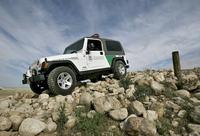-
Turf wars: math model shows crimes cluster on borders between rival gangs

A mathematical model that has been used for more than eighty years to determine the hunting range of animals in the wild holds promise for mapping the territories of street gangs; among other things, the research demonstrates that the most dangerous place to be in a neighborhood packed with gangs is not deep within the territory of a specific gang, as one might suppose, but on the border between two rival gangs
-
-
Greater L.A. to heat up an average 4 to 5 degrees by mid-century
A groundbreaking new study shows that temperatures in the Los Angeles region to rise by an average of 4 to 5 degrees Fahrenheit by the middle of this century, tripling the number of extremely hot days in the downtown area and quadrupling the number in the valleys and at high elevations
-
-
Significant sea-level rise in a 2-degree warming world
Sea levels around the world can be expected to rise by several meters in coming centuries, if global warming carries on; even if global warming is limited to 2 degrees Celsius, global-mean sea level could continue to rise, reaching between 1.5 and 4 meters above present-day levels by the year 2300
-
-
Finding the best ways to protect infrastructure, recover from disasters
Researchers at Sandia National Lab bring the quantitative methods they have developed to the analysis of disasters and how best to recover from them; the researchers look at interdependencies among systems and supply chains, the resilience of various systems, how infrastructure systems fail, cascading effects, and how results might differ if a series of disasters hits instead of just one; the Sandia researchers say they can better quantify the results of such resiliency studies by taking a mathematically rigorous approach to objective assessments
-
-
California coastal infrastructure at risk from rising sea levels
An exhaustive study by the National research Council finds projects that the sea level off most of California is likely to rise about one meter over the next century, an amount slightly higher than projected for global sea levels; this will place much of the state coastal infrastructure at risk, because significant development along the coast — such as airports, naval air stations, freeways, sports stadiums, and housing developments — has been built only a few feet above the highest tides; for example, the San Francisco International Airport could flood with as little as 40 centimeters of sea-level rise
-
-
Seeping Arctic methane to pose serious problems for Florida coastline

Large quantities of methane gas are buried under the Arctic permafrost; the melting of ice caps in the Arctic causes this gas to escape into the atmosphere through vents; until recently, cryosphere (frozen soil and ice) has served to plug or block these vents, but thawing conditions have allowed the conduits to open, and deep geologic methane now escapes; methane is a very strong greenhouse gas, and its presence in the atmosphere has grown three times faster than carbon dioxide since the industrial era
-
-
Forensic research using DNA sequencing technology
The Ion Personal Genome Machine (PGM) Sequencer translates chemical sequencing information directly into digital form by using semiconductor technology; it enables the analysis of ninety-six samples in one run, allowing forensic practitioners to obtain more information from the samples they process; the sequencer is suitable for a wide array of forensic identification applications, including missing persons identifications, mass disaster work, interpretations of complex mixtures, and bio-defense
-
-
Paper-printed rapid disease detection test
Complex laboratory investigations do produce reliable results, but they are not useful for point-of-care diagnostics; researchers have come up with a clever idea: biosensors based on paper; the test is printed on one side of a chromatography paper, the paper is folded up origami-style, laminated, and the test is ready; test evaluation requires only a voltmeter
-
-
Larger role for renewable energy in U.S. future than previously thought

Renewable electricity generation from technologies that are commercially available today, in combination with a more flexible electric system, is more than adequate to supply 80 percent of total U.S. electricity generation in 2050 while meeting electricity demand on an hourly basis in every region of the country; new study finds that renewable generation could play a more significant role in the U.S. electricity system than previously thought
-
-
Water for central Everglades essential for reversing ecosystem's decline
Twelve years into a $13.5billion state and federal effort to save the Florida Everglades, little progress has been made in restoring the core of the ecosystem, says a new congressionally mandated report from the National Research Council; expedited restoration projects that improve the quality and amount of water in this area are necessary to reverse ongoing declines
-
-
House bill allows Border Patrol to ignore environmental, safety protections along borders

The House of Representatives passed a sweeping bill which would allow the Border Patrol to ignore dozens of environmental protection laws — among them the Wilderness Act and Endangered Species Act — on all federally managed land within 100 miles of the Mexico and Canada borders; supporters argue that the measure is necessary to give the border patrol more freedom to chase illegal immigrants and drug smugglers; critics charge that the measure has little, if anything, to do with border security, and more to do with opening federally managed land to exploitation by private businesses, or pandering to local political constituencies
-
-
Carbon capture and storage likely to cause earthquakes
Carbon capture and storage, or CCS, is a major component of the world’s greenhouse gas reduction strategy; to make a significant contribution to emission reduction, however, CCS would need to operate on a massive scale, potentially sequestering upward of 3.5 billion metric tons of CO2 each year; researchers say that the injection of massive quantities of CO2 would be likely to induce small temblors which would break the reservoirs’ seals and release the stored CO2 into the atmosphere
-
-
Do nano-pesticides hold promise or pose threat to greener agriculture?
Nanotechnology has developed significantly in the past decade and was able to create many new materials with a vast range of potential applications; the risk that nano-particles may pose to human and environment health, however, is not yet fully understood; a precautionary principle suggests keeping environmental release of nano-particles minimal until their fate and toxicity is better understood
-
-
Exploring the Bermuda Triangle's swirling vortices

Researchers, funded by the Office of Naval Research, deployed twenty-one underwater probes to study vortices at the Bermuda Triangle; a vortex is a swirl of water that can be created in several ways, including water being pushed between land masses and then released into the open ocean; the oceanographers did well to lose only one of the underwater probes, considering they were studying the notorious Triangle
-
-
3-in-1 water monitoring system
All water treatment plants using membrane technology are required to be able to perform three processes to comply with international standards: identify whether there are any bacteria or contaminants; detect any broken membrane filters in the treatment plant; and pinpoint which filter is broken — accurate to 1 in 100,000 filters; a new, innovative device performs all three processes
-
More headlines
The long view
Are We Ready for a ‘DeepSeek for Bioweapons’?
Anthropic’s Claude 4 is a warning sign: AI that can help build bioweapons is coming, and could be widely available soon. Steven Adler writes that we need to be prepared for the consequences: “like a freely downloadable ‘DeepSeek for bioweapons,’ available across the internet, loadable to the computer of any amateur scientist who wishes to cause mass harm. With Anthropic’s Claude Opus 4 having finally triggered this level of safety risk, the clock is now ticking.”
A Brief History of Federal Funding for Basic Science
Biomedical science in the United States is at a crossroads. For 75 years, the federal government has partnered with academic institutions, fueling discoveries that have transformed medicine and saved lives. Recent moves by the Trump administration — including funding cuts and proposed changes to how research support is allocated — now threaten this legacy.
Bookshelf: Preserving the U.S. Technological Republic
The United States since its founding has always been a technological republic, one whose place in the world has been made possible and advanced by its capacity for innovation. But our present advantage cannot be taken for granted.
Autonomous Weapon Systems: No Human-in-the-Loop Required, and Other Myths Dispelled
“The United States has a strong policy on autonomy in weapon systems that simultaneously enables their development and deployment and ensures they could be used in an effective manner, meaning the systems work as intended, with the same minimal risk of accidents or errors that all weapon systems have,” Michael Horowitz writes.
Ukraine Drone Strikes on Russian Airbase Reveal Any Country Is Vulnerable to the Same Kind of Attack
Air defense systems are built on the assumption that threats come from above and from beyond national borders. But Ukraine’s coordinated drone strike on 1 June on five airbases deep inside Russian territory exposed what happens when states are attacked from below and from within. In low-level airspace, visibility drops, responsibility fragments, and detection tools lose their edge. Drones arrive unannounced, response times lag, coordination breaks.
Shots to the Dome—Why We Can’t Model US Missile Defense on Israel’s “Iron Dome”
Starting an arms race where the costs are stacked against you at a time when debt-to-GDP is approaching an all-time high seems reckless. All in all, the idea behind Golden Dome is still quite undercooked.
